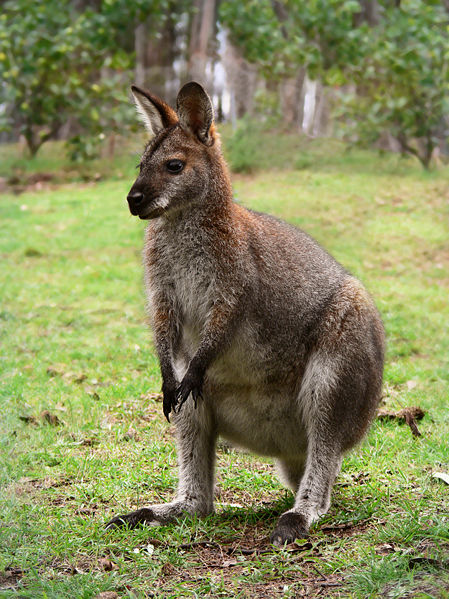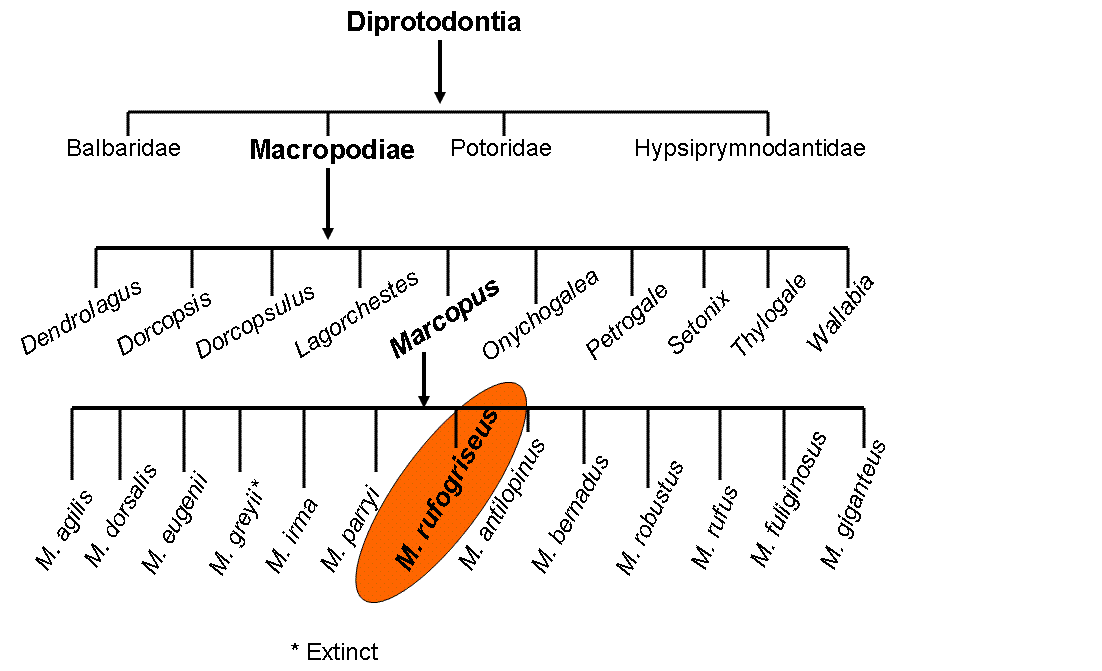 Macropus
rufogriseus
Macropus
rufogriseusRed-Necked Wallaby

 :: Classification
:: Classification
Where does the Red-Necked Wallaby
belong, and why does it fit into each taxonomical level?

Domain: Eukaryotes
Eukaryotes are organisms that have complex cells with a nucleus, and membrane bound organelles. It also contains a cytoskeleton and DNA.
Kingdom: Animalia
Animalia are described as organisms that are multicellular, eat other organisms for food, and are usually motile.
Phylum: Chordata
Chordates are described by having five characteristics. These include; a notochord, dorsal nerve chord, pharyngeal slits, endostyle, and post anal tail.
Class: Mammalia
Mammals have bodies that are covered with hair and are homeothermic. They are also have glands such as sweat, sebaceous, and mammary glands.
Subclass: Marsupials
Marsupials have a pouch on their abdomen where they nourish their young after a very short time in the uterus.
Order: Diprotodontia
Diprotodontia are distinguished by their teeth and paws. They have a short jaw, that contains two front teeth, three pair of upper incisors, and a large pair of incisors on the lower jaw. The paw of these organisms have four digits. The second and third digit are fused together until the claws, and the fourth digit is enlarged.
Family: Macropidae
A characteristic of the Macrpopidae is also its teeth. They have a straight row of teeth in the front of the mouth, and have large molars. They do not however have canine teeth. They also have a specialized digestive system, which is important to digest plant material. The more noticeable characteristics of this group is its long muscular tail, and large hind feet. Macropod means "big feet". Lastly they have a small head, large ears, and a pouch that opens forward.
Genus: Macropus
Marsupial genus that include Kangaroos, wallaroos and wallabies.
Species: Macropus rufogriseus
This specie is identified by the red color around it's neck and shoulders. It's fur is grey or brown and it has a white stripe on it's upper lip.

This phylogenetic tree was self created using morphological data. The species included are the closest living and extinct relatives of the Red-necked Wallaby. The top starts with the Red-necked Wallaby's order, Diprotodontia, then breaks down into family(Macropodiae), genus(Macropus), and species(Macropus rufogriseus). All the species listed are divided into this group by one main characterisict, their large feet. Macropod after all does mean "long foot". The closest relatives of the Red-necked Wallaby are the six species located to the left of M. rufogriseus on the tree above. These seven, including M. ruforiseus, all belong to the subgenus Notamacropus. The seven species are all wallabies and are divided into their species by physical characteristics. The most common characteristics used to differentiate species are fur color and also size, which includes small, medium and large wallabies. Following the table, the next four to the right of the Red-necked Wallaby are in the subgenus Osphranter, and the last two belong to the subgenus Macropus. Members of the Osphranter include kangaroos and wallaroos. Macropus include the Eastern and Western Grey Kangaroo.
Learn about their Habitat!!

Domain: Eukaryotes
Eukaryotes are organisms that have complex cells with a nucleus, and membrane bound organelles. It also contains a cytoskeleton and DNA.
Kingdom: Animalia
Animalia are described as organisms that are multicellular, eat other organisms for food, and are usually motile.
Phylum: Chordata
Chordates are described by having five characteristics. These include; a notochord, dorsal nerve chord, pharyngeal slits, endostyle, and post anal tail.
Class: Mammalia
Mammals have bodies that are covered with hair and are homeothermic. They are also have glands such as sweat, sebaceous, and mammary glands.
Subclass: Marsupials
Marsupials have a pouch on their abdomen where they nourish their young after a very short time in the uterus.
Order: Diprotodontia
Diprotodontia are distinguished by their teeth and paws. They have a short jaw, that contains two front teeth, three pair of upper incisors, and a large pair of incisors on the lower jaw. The paw of these organisms have four digits. The second and third digit are fused together until the claws, and the fourth digit is enlarged.
Family: Macropidae
A characteristic of the Macrpopidae is also its teeth. They have a straight row of teeth in the front of the mouth, and have large molars. They do not however have canine teeth. They also have a specialized digestive system, which is important to digest plant material. The more noticeable characteristics of this group is its long muscular tail, and large hind feet. Macropod means "big feet". Lastly they have a small head, large ears, and a pouch that opens forward.
Genus: Macropus
Marsupial genus that include Kangaroos, wallaroos and wallabies.
Species: Macropus rufogriseus
This specie is identified by the red color around it's neck and shoulders. It's fur is grey or brown and it has a white stripe on it's upper lip.
This phylogenetic tree was self created using morphological data. The species included are the closest living and extinct relatives of the Red-necked Wallaby. The top starts with the Red-necked Wallaby's order, Diprotodontia, then breaks down into family(Macropodiae), genus(Macropus), and species(Macropus rufogriseus). All the species listed are divided into this group by one main characterisict, their large feet. Macropod after all does mean "long foot". The closest relatives of the Red-necked Wallaby are the six species located to the left of M. rufogriseus on the tree above. These seven, including M. ruforiseus, all belong to the subgenus Notamacropus. The seven species are all wallabies and are divided into their species by physical characteristics. The most common characteristics used to differentiate species are fur color and also size, which includes small, medium and large wallabies. Following the table, the next four to the right of the Red-necked Wallaby are in the subgenus Osphranter, and the last two belong to the subgenus Macropus. Members of the Osphranter include kangaroos and wallaroos. Macropus include the Eastern and Western Grey Kangaroo.
Learn about their Habitat!!





